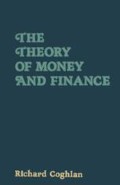Abstract
In recent years the monetarist approach to macroeconomic analysis has gained increasing acceptance as a framework for interpreting economic behaviour, and has consequently become more important in discussing the policy options facing the authorities. Monetary variables have come to play an increasing role in the large scale macroeconomic models, particularly in the United States; for a comprehensive survey, see Fisher and Sheppard (1972). The monetarists have, however, tended to concentrate on simpler, highly aggregative, reduced-form models in their attempt to demonstrate the overwhelming influence of money on the economy, in particular on prices and the rate of inflation. Strangely, this work has received scant attention in macro and monetary textbooks, and yet it would seem essential to a proper understanding of the monetarist position. This chapter therefore briefly summarises the debate, and the evidence that has been presented.
Preview
Unable to display preview. Download preview PDF.
References
S. Almon, ‘The Distributed Lag between Capital Appropriations and Expenditures’, Econometrica, Jan 1965.
L. C. Andersen and K. M. Carlson, ‘A Monetarist Model for Economic Stabilization’, Federal Reserve Bank of St Louis Monthly Review, vol. 52, no. 4, Apr 1970.
L. C. Andersen and J. L. Jordan, ‘Monetary and Fiscal Actions: A Test of their Relative Importance in Economic Stabilization’, Federal Reserve Bank of St Louis Monthly Review, vol. 50, no. 11, Nov 1968.
A. Ando and F. Modigliani, ‘The Relative Stability of Monetary Velocity and the Investment Multiplier’, American Economic Review, vol. 55.
M. Artis and R. Nobay, ‘Two Aspects of the Monetary Debate’ National Institute Economic Review, no. 49, Aug 1969.
C. R. Barrett and A. A. Walters, ‘The Stability of Keynesian and Monetary Multipliers’, Review of Economics and Statistics, vol. 48, no. 4, Nov 1966.
T. F. Cargill and R. A. Meyer, ‘Some Time and Frequency Domain Distributed Lag Estimators: A Comparative Monte Carlo Study’, Econometrica, Nov 1974.
E. H. Chamberlin, The Theory of Monopolistic Competition (London: Oxford University Press, 1933).
R. T. Coghlan, ‘Bank Competition and Bank Size’, Manchester School, vol. XLII, no. 2, June 1975.
F. Cripps, W. Godley and M. Fetherston, ‘Public Expenditure and the Management of the Economy’, Memorandum submitted to the House of Commons Expenditure Committee, and published in their Ninth Report on Public Expenditure, Inflation and the Balance of Payments (London: H.M.S.O., 13 Aug 1974).
A. D. Crockett, ‘Timing Relationships between Movements of Monetary and National Income Variables’, Bank of England Quarterly Bulletin, vol. 10, no. 4, Dec 1970.
S. K. Edge, ‘The Relative Stability of Monetary Velocity and the Investment Multiplier’, Australian Economic Papers, Dec 1967.
G. R. Fisher and D. K. Sheppard, Effects of Monetary Policy on the United States Economy: A Survey of Econometric Evidence (Paris: O.E.C.D., Dec 1972).
M. Friedman, ‘The Methodology of Positive Economics’, in Essays in Positive Economics (University of Chicago Press, 1953).
M. Friedman and D. Meiselman, ‘The Relative Stability of Monetary Velocity and the Investment Multiplier in the United States, 1897–1958’, Research Study Two in Stabilization Policies, prepared by E. Cary Brown et al. for the Commission on Money and Credit (Englewood Cliffs, N.J.: Prentice-Hall, 1963).
W. Godley and F. Cripps, ‘Demand Inflation and Economic Policy’, London and Cambridge Economic Bulletin, no. 84; reprinted from The Times, 22 and 23 Jan 1974.
S. M. Goldfeld and A. S. Blinder, ‘Some Implications of Endogenous Stabilization Policy’, Brookings Papers on Economic Activity, no. 3, 1972.
C. A. E. Goodhart, ‘Monetary Relationships: A View from Threadneedle Street’, in Papers in Monetary Economics, vol. 1 (Reserve Bank of Australia, 1975).
C. A. E. Goodhart and A. Crockett, ‘The Importance of Money’, Bank of England Quarterly Bulletin, vol. 10, no. 2, June 1970.
C. W. J. Granger, ‘Investigating Causal Relations by Econometric Models and Cross-Spectral Methods’, Econometrica, vol. 37, July 1969.
B. Hansen, ‘On the Effects of Fiscal and Monetary Policy: A Taxonomic Discussion’, American Economic Review, vol. 63, no. 4, Sep 1973.
J. R. Hicks, ‘A Suggestion for Simplifying the Theory of Money, Economica, Feb 1935; reprinted in
J. R. Hicks Critical Essays in Monetary Theory (London: Oxford University Press, 1967).
N. Kaldor, ‘The “New” Monetarism’, Lloyds Bank Review, no. 97, July 1970.
London Business School Centre for Economic Forecasting, Economic Outlook 1977–80, 1977.
F. Modigliani, ‘The Monetarist Controversy, or Should we Foresake Stabilization Policies?’, American Economic Review, vol. 67, no. 2, 1977.
*W. Poole and E. B. F. Kornblith, ‘The Friedman-Meiselman C.M.C. Paper: New Evidence on an Old Controversy’, American Economic Review, vol. 63, Dec 1973.
W. Rees-Mogg, ‘How a 9.4% Excess Money Supply gave Britain 9.4% inflation’, The Times, 13 July 1976; see also ‘Programme for Economic Stability’, leader in The Times, 20 Sep 1976.
J. Robinson, Economics of Imperfect Competition (London: Macmillan, 1933).
C. A. Sims, ‘Money, Income and Causality’, American Economic Review, vol. 62, no. 4, Sep 1972.
R. Tarling and F. Wilkinson, ‘Inflation and Money Supply’, in Economic Policy Review, no. 3, Department of Applied Economics, University of Cambridge, Mar 1977.
D. Williams, C. A. E. Goodhart and D. H. Gowland, ‘Money, Income, and Causality: The U.K. Experience’, American Economic Review, vol. 66, no. 3, June 1976.
Copyright information
© 1980 Richard Coghlan
About this chapter
Cite this chapter
Coghlan, R. (1980). The Causality Debate. In: The Theory of Money and Finance. Palgrave, London. https://doi.org/10.1007/978-1-349-86121-7_3
Download citation
DOI: https://doi.org/10.1007/978-1-349-86121-7_3
Publisher Name: Palgrave, London
Print ISBN: 978-0-333-25644-2
Online ISBN: 978-1-349-86121-7
eBook Packages: Palgrave Economics & Finance CollectionEconomics and Finance (R0)

